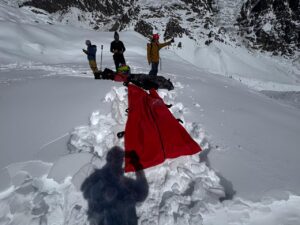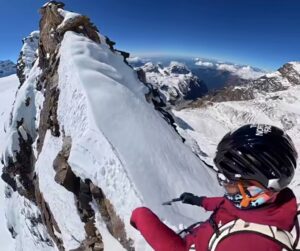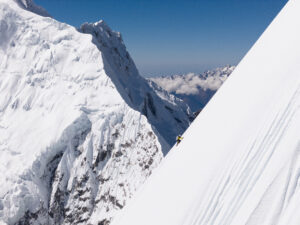Though a small country, Bhutan claims 21 peaks higher than 7,000m, including the highest unclimbed mountain in the world, Gankhar Puensum (7,570m). But of those that have been climbed, it’s the sub-7,000m Jitchu Drake that has the most interesting mountaineering history.
Mountaineering in Bhutan
Bhutan’s huge peaks shielded the country for centuries. It only opened to tourism in 1974. Even today, tourists need to be accompanied by an officially registered travel agency to visit the country.
However, early in the 20th century, a few alpinists and explorers did make it into Bhutan. In 1924, English geologist and alpinist Noel Odell explored 7,326m Jomolhari Peak. In 1963, explorer Augusto Gansser explored the same area and made a topographical map.

Jomolhari. Photo: Marko Prezelj
In 1937, Frederick Spencer Chapman and Sherpa Pasang Dawa Lama made the first ascent of Jomolhari. Its second ascent came more than 30 years later and ended in tragedy when two members of the joint Indo-Bhutanese expedition disappeared near the summit.
Gankhar Puensum was first measured in 1922, with no climbing activity until the 1980s. It remains unclimbed.
In 1958, a Japanese expedition led by Sasuke Nakao explored Bhutan, scouting future climbing projects.
“The full view of the mountains was oppressive,” Nakao wrote. “At the northwestern corner of the Bhutan border, many 7,000m peaks are gathered, all glittering above the gentle alpine meadows of yaks grazing. The Bhutan Himalaya, in general, is not steep. It is rather slow and gentle and thickly covered by dense forests. It contains very wide alpine highlands, and the peaks, higher than 6000 metres, abruptly tower from the green pastures.”
In 1994, Bhutan forbade climbing mountains higher than 6,000m out of deference to local beliefs. Then in 2003, it banned all mountaineering. But between 1983 and 1994, when Bhutan briefly allowed it, a few peaks saw interesting climbs. Perhaps the most interesting during this period occurred on Jitchu Drake.
Jitchu Drake
Nestled in the Great Himalaya near the border with Tibet, Jitchu Drake is an impressive pyramid that immediately draws your attention. The name means “Angry Swallow”, and the mountain is considered to be the guardian deity of Paro, a town located in the Paro Valley.

Jitchu Drake. Photo: Summitpost
The height of Jitchu Drake is not entirely settled. Different sources indicate an altitude between 6,662m and 6,989m. Doug Scott wrote 6,790m, the official height given by the Bhutanese authorities at the time, but it is more likely 6,989m. A lower southern peak measures 6,800m.
According to legend, Jitchu Drake teased a young girl while she was weaving. The girl hit him on the head with a piece of wood, producing the double peak.

The Great Himalaya in Bhutan. Photo: Yala Adventure
The first attempt on Jitchu Drake
In 1962, Japanese climber Junko Tabei joined a small mountaineering club. “Almost every weekend I went out to a mountain area and during the week after work, I trained,” she recalled. “I started dreaming of going to the Himalaya with an all-female team. For that reason, we formed the Ladies’ Climbing Club.”
In 1975, Tabei became the first woman to summit Everest. Eight years later, in the spring of 1983, she led the women in her Club to Jitchu Drake. On April 30, they established a base camp at 4,300m by a beautiful lake close to the mountain. They aimed to climb the east ridge.
On May 1, they set up Camp 1 at 4,600m and two days later, they made Camp 2 at 5,105m. But above Camp 2, it proved so steep and difficult that they gave up on May 14.
However, they did not go home empty-handed. They had permission to climb Sepchu Kang (5,200m), which they summited on May 20.

Jitchu Drake beyond Tso Phu. Photo: Alan Elliott
An Austrian team summits the South Peak
At the same time, and almost parallel to them on another slope of the mountain, an Austrian team led by Eduard Ratheiser arrived. With him were five climbers, Werner Sucher, Albert Egger, Alois Stuckler, Sepp Mayerl, and Toni Ponholzer. The Austrians chose to climb the southwest ridge.
They established Camp 1 at the foot of the ridge, at 4,800m. From there, they faced enormous difficulties, with very difficult rock and ice climbing. They eventually established Camp 2 at 5,600m, but the climbing was not getting easier.
“The ice above Camp 2 on the knife-edge ridge, which was up to 70°, was the most difficult part of the climb,” Ratheiser wrote in his report for the American Alpine Club.
On May 15, after eight days, they managed to put up a small tent on an ice ledge on the exposed ridge at 6,096m. This was their Camp 3. There was not enough space for all five climbers, so Sucher, Egger, and Stuckler advanced to 6,500m, where they bivouacked.
After the bivouac, the team reunited. Two days later, on May 17, 1983, they reached the south summit.
“On the summit, our altimeter showed about 6,800m,” Ratheiser wrote. Though they succeeded, they were not lucky with the weather. During the 21 days, it snowed every afternoon.
Japanese on the (south)east ridge
One year later, in May 1984, another Japanese expedition arrived to take on the southeast ridge. They set up base camp on May 4 at 4,500m by a glacial lake. Led by Kuniaki Yagihara, the team included Ataru Deguchi, Noboru Sudo, Keiichi Sudo, Masahiko Chigara, Takuko Kikuchi, Kenzo Shinmazu, Moriya Hara, and Shoji Seki.
Their route differed from the Japanese women’s team. They took a shorter route to ascend to a col at 5,300m on the east ridge.

Jitchu Drake from Jomolhari base camp.
It took them almost two weeks, but on May 20, Keiichi Sudo, Hara, Deguchim Shinmazu, and Yagihara summited the lower south summit of Jitchu Drake. The team fixed 3,000m of rope, all the way to the summit.
Tragedy in the autumn of 1984
A team from the Italian Alpine Club, under the leadership of Arturo Bergamaschi, wanted to repeat the same elegant line.
The 13-man team arrived at their base camp at the end of August 1984. The team included climbers Giorgio Corradini, Tiziano Nannuzzi, Graziano Ferrari, Filippo Sala, and Rolando Menardi, among others.
Initially, they progressed well, despite the long, sharp snow ridge. On September 2, they established Camp 1 at 5,350m. But before they could continue toward Camp 2, they had to pause because of bad weather.

The south face of Jitchu Drake. Photo: Doug Scott
On September 9, Ferrari, Corradini, Sala, and Menardi fixed ropes to 5,700m. Two days later, Corradini, Nannuzzi, and Sala reached 5,900m. But again, the weather turned and they had to stop for two days.
On September 15, when Nannuzzi and Corradini were packing up camp, the crest of the snow ridge broke off. Both fell 760m down the precipitous east face. Their compatriots tried to search, with help from Bhutanese soliders and a helicopter, but bad weather and the inaccessibility of the area thwarted any attempt to find the climbers’ remains.
Doug Scott
“A visit to Bhutan had been on the agenda since the mid-1960s when that great Himalayan explorer Augusto Gansser published photographs of unclimbed 7,000m peaks,” Doug Scott wrote in the Alpine Journal. “My interest grew further as a result of a chance meeting at the Darjeeling trekking conference in 1985.”
After the conference, Scott and Mike Westmacott went on a short trip to Sikkim. There, they met Maggie Payne, a Canadian citizen who was running a trekking operation in the Middle East. Payne was curious to visit Bhutan, and the three started to talk about how to obtain a permit for Gankhar Puensum. Payne visited Bhutan several times over the following years and eventually told Scott that she had secured permission for him to climb Jitchu Drake.

Doug Scott. Photo: ITV
On May 5, 1988, Scott, Victor Saunders, Neil Lindsay, Lindsay Griffin, David Rose (a reporter for The Guardian), and Sharu Prabhu arrived at Thangothang. Scott had met Prabhu at the 1985 conference and had since climbed with her in Jordan and India. The team acclimatized for the next two weeks around Jitchu Drake.

The southeast ridge of Jitchu Drake. The main peak is on the right. Photo: Doug Scott
Eventually, they decided on the south face of Jitchu Drake. A few days later, the team established Camp 1 at 5,486m on a great ice shelf. After, they returned to base camp to rest before the actual climb.
During the climb, Scott led the route up the corniced ridge until they reached a flat enough area to put up their bivy tents. The next day, Saunders and Scott decided to set up a higher camp that was more protected. Later, they all moved up, occupying what was probably the Japanese camp. Griffin and Rose did not continue any higher, but Saunders, Prabhu, and Scott were off toward the summit at 2:30 am on May 30.
They first reached the south summit and had to descend 30m along the corniced ridge before climbing 305m up on the west side of the main summit, where they arrived at midday.

Looking east over the Himalayan Divide. Bhutan is on the right, Tibet is on the left. Photo: Doug Scott
No new climbs are likely
All mountaineering has remained banned in Bhutan since 2003.
The mountains are a key part of Bhutanese culture. Respecting the deities who live on these high peaks is essential. They believe that climbing restrictions are necessary to preserve their cultural and natural heritage. Considering the situation on mountains such as Everest, the restrictions are likely to stay. In Bhutan, spiritual matters remain more important than commercial opportunities.






